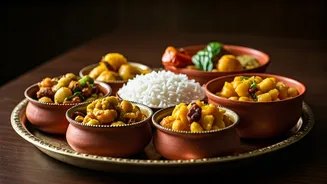Mindful Mealtime Rituals
Ancient Indian wisdom emphasizes a mindful approach to eating, viewing food as a sacred offering. One key ritual involves eating in a calm, serene environment,
free from distractions like television or smartphones. This encourages full attention to the flavors, textures, and aromas of the food. Another core practice is eating with gratitude, acknowledging the journey of the food from its source to the plate. This can be expressed through a simple prayer or a moment of silent reflection before the meal. Such rituals help cultivate awareness of hunger cues and promote a deeper connection with the food, aiding in better digestion and overall well-being. Practicing these mindful eating habits can transform the dining experience into a ritual of nourishment and appreciation, offering benefits that extend far beyond physical health.
Food Group Harmony
Traditional Indian cuisine often emphasizes the balanced consumption of various food groups in each meal. This ritual is rooted in the belief that a well-rounded diet is essential for holistic health. Meals frequently include carbohydrates, proteins, fats, and essential micronutrients. Consider the common practice of combining rice (carbohydrate), lentils (protein), vegetables (vitamins and minerals), and ghee or oil (fats). Each food group plays a specific role in providing the body with energy, building blocks, and essential nutrients. This balanced approach helps ensure the body receives everything it needs to function optimally, preventing deficiencies and promoting overall health. The practice also promotes satiety and reduces the likelihood of overeating. By consciously including a diverse range of foods in each meal, individuals can benefit from a synergistic effect that promotes both physical and mental well-being.
The Art of Chewing
Thorough chewing is a cornerstone of traditional Indian eating habits and is considered a key ritual for optimal digestion. The emphasis is on chewing each bite until it becomes a fine paste before swallowing. This practice aids digestion by breaking down food into smaller particles, making it easier for the body to absorb nutrients. Saliva, which contains enzymes essential for carbohydrate digestion, mixes with the food during chewing, preparing it for the next stages of the digestive process. Thorough chewing also helps regulate appetite and promotes satiety, preventing overeating. The practice encourages mindful eating by slowing down the eating process and allowing the individual to savor the flavors and textures of the food. Incorporating this seemingly simple ritual into daily eating habits can significantly improve digestive health and overall well-being.
Eating According To Dosha
Ayurveda, the ancient Indian system of medicine, suggests the importance of tailoring eating habits to individual body types or doshas. The three doshas – Vata, Pitta, and Kapha – represent different combinations of elements within the body. Eating according to one’s dosha involves consuming foods that balance the specific characteristics of that dosha. For example, individuals with a Vata dosha are often advised to eat warm, cooked foods and avoid cold, dry items to maintain balance. Those with a Pitta dosha may benefit from cooling foods and avoiding spicy, oily foods. Kapha individuals may benefit from light, dry foods. The emphasis is on understanding one's unique constitution and choosing foods that support that balance. Eating according to the dosha can promote better digestion, reduce imbalances, and enhance overall health. This personalized approach to nutrition aligns with the Ayurvedic principle of treating each individual as unique and tailoring health practices accordingly.
Seasonal Eating
Following the principles of seasonal eating is another fundamental ritual in Indian cuisine. This practice involves consuming foods that are naturally available during a particular season. It aligns with the idea that nature provides the body with the nutrients needed at specific times of the year. For instance, in the summer, cooling fruits and vegetables, such as cucumbers and watermelons, are favored to combat the heat. In winter, warming foods and spices, like ginger and cardamom, are often included in meals. Seasonal eating ensures a diverse intake of nutrients and supports the body’s natural rhythms. The practice also promotes sustainability and reduces the environmental impact of food production. By eating foods that are readily available in each season, individuals can enjoy the freshest, most flavorful ingredients while supporting their health and the environment.











